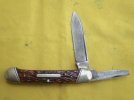- Joined
- May 6, 2012
- Messages
- 3,557

So I know in the past there’s been talk of Cattle knives and the Stockman evolution on the forum, I’m curious as to the Canoe pattern origins? All I’ve been able to dig up is it was supposedly a scaled down version of the cattle knife made more pocket friendly and showed up sometime around 1915. I’m just curious, I’ve grown to appreciate over the past few years the Copperlock introduced in 1997 and Mini Copperlock in 1998 for their pocket friendliness as being thin and snag free, for the same reasons I like the Canoe in the summer. Seems that all the original patterns with the Copperhead bolsters from Case as far as I can tell which includes the Copperhead, Canoe, Case Saddle Horn seems to appear sometime prior to 1915 seems sort of vague, were these released as a series at the time? I often look at my Canoe as a for lack of a better term as an equal end non locking Copperlock, so anyone have any solid history or I guess heck any folklore as there is not much out their in the pattern.
found this which I find curious as I’ve never seen a Canoe Jack but it sure does look cool



